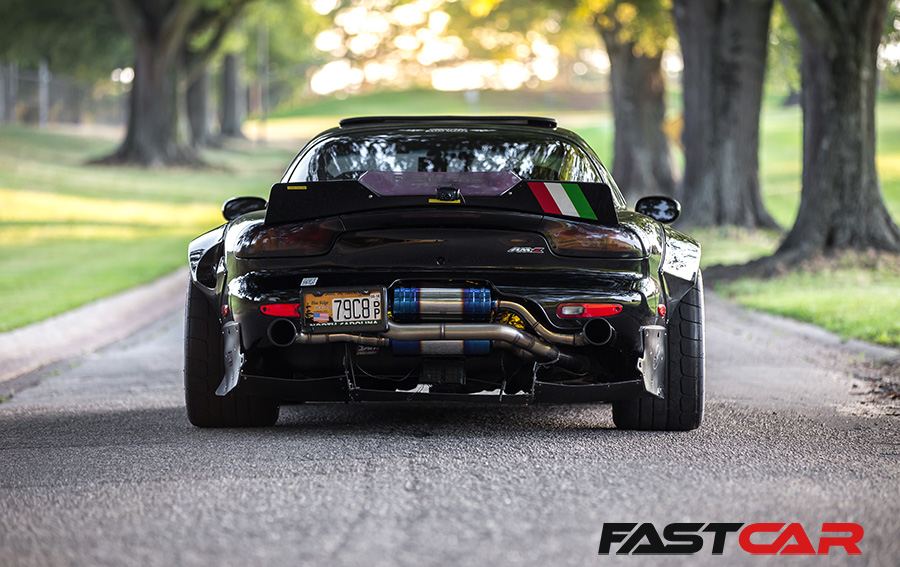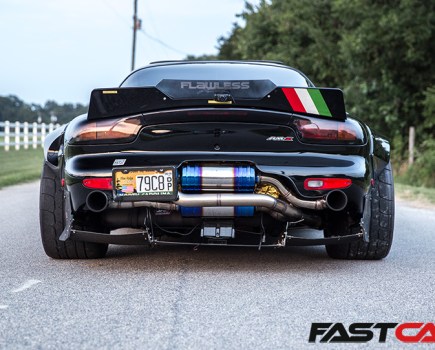There’s no doubt that a performance cat-back exhaust system is one of the all-time great tuning mods. So, let’s have a little look at what they’re all about.
A cat-back exhaust is exactly what it says on the tin. It’s the part of your exhaust system that runs from the catalytic converter to the back of your car. It doesn’t matter if it’s a standard system or an aftermarket exhaust upgrade, it’s the bit that includes the mid pipe(s), silencers and back box. Everything after the cat, up to the tailpipe. It’s been an all time favorite car modification since tuning began…
If you happen to be driving a diesel, you will have a diesel particulate filter (DPF) instead of a cat. However, the same principle applies. Cat-back exhaust or DPF-back, we’re looking at the portion of the exhaust which takes care of the gases after they’ve exited the legally required, factory-fitted emission control system.
We guess that this answers the main question, then… but it’s a little un-FC-worthy to leave it there, isn’t it? So, let’s delve a little deeper into the science, and see why upgrading to a performance cat-back exhaust is almost always a no-brainer.
What is an emission control system?
What is a catalytic convertor (cat)? And what’s a DPF come to think of it? Well, it goes without saying that car manufacturers are under increasing pressure to produce vehicles that churn out smaller volumes of emissions. But this isn’t a new thing. Legislation on what’s coming out of your tailpipe has been tightening up for the last half century. And the clean air regulations imposed by many of the world’s governments is as important to car owners, modifiers and tuners as it is to the manufacturers themselves. Chiefly because it dictates what you legally can and can’t do to your exhaust system. At least if you’d like to drive your car on the road.
The catalytic converter was one of the first control systems for petrol-powered vehicles. These have been around since the 19th century. However, it wasn’t until the ‘70s and ‘80s when we started seeing them in the mainstream. Unlike nowadays where it’s all about keeping those CO2 figures acceptable though, cats were rolled out on production cars due to legislation on the type of emissions that all petrol engines produce.
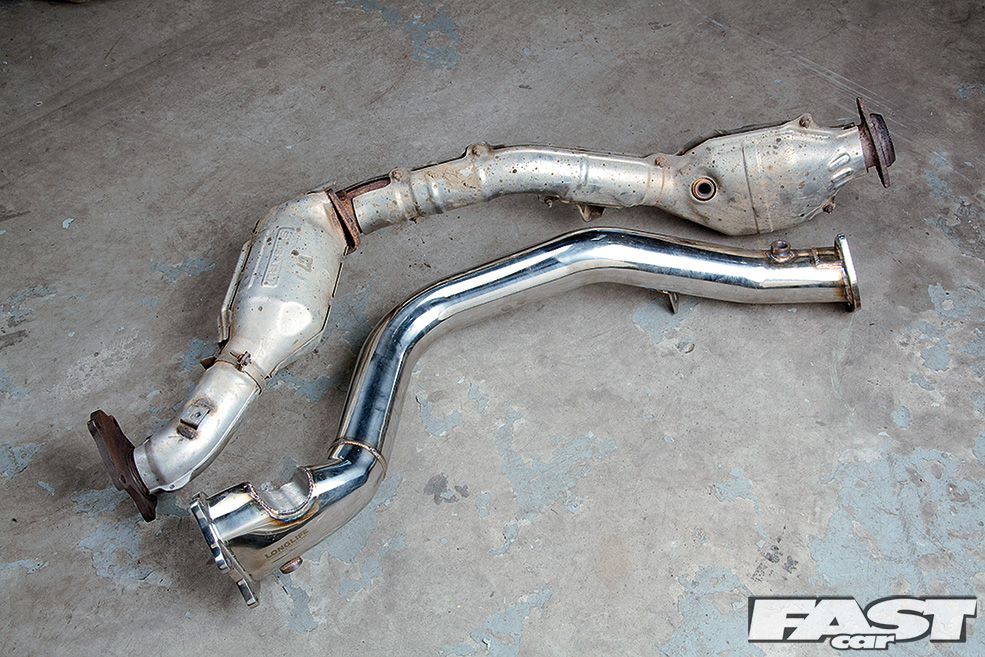
How does a catalytic convertor work?
The main purpose of a cat is to promote a chemical reaction to turn toxic gasses into less harmful emissions. This is why they’re often called a catalyst, because they catalyze the reaction. Petrol engines mostly kick out carbon monoxide (CO) and unburned hydrocarbons (HC) – all the noxious stuff you don’t want to be breathing in.
What your cat does is help these gasses to combine with oxygen to produce carbon dioxide (CO2) and water (H20), emissions that won’t kill you quite as quicky. Yep, that’s right, your cat is what makes your car produce CO2 in the first place. But, although we know that CO2 isn’t great for climate change, it’s still far better than the gasses that every petrol engine on the planet would produce without a catalyst in place. Here in the UK at least, this is why every car registered after 1993 must have a cat to pass an MOT emissions test.
How does a diesel particulate filter work?
As you can imagine, regulations for those dirty diesels are even more stringent. Every oil burner has been fitted with a DPF since 2013, and if you get caught without your fitted, you’ll earn yourself an instant £1000 fine. It’s not just the emissions that are scrutinized during your MOT, either. The tester has to actually see your DPF in place for you to pass. Random roadside testing is also common all around the UK.
Now, although a DPF works in a different way, you can think of it like a cat. The clue is in the name here, a DPF is basically a big filter to designed to catch the soot produced by the diesel engine. It then goes through a re-generation cycle to burn off the heavy particulates before they’re released. In this way a DPF will remove 85-95% of the soot from your emissions.
You’ll find your cat or DPF either on the downpipe or underneath the vehicle, but they’ll always be close to the engine. The reason for this is because they need to get extremely hot to work effectively – around 400 DegC for a cat, and 600 DegC for a DPF. They’re also relatively expensive parts, much more so than the rest of the system. This is why the cat-back or DPF-back portion is the easiest and most cost-effective part to replace with a performance upgrade.
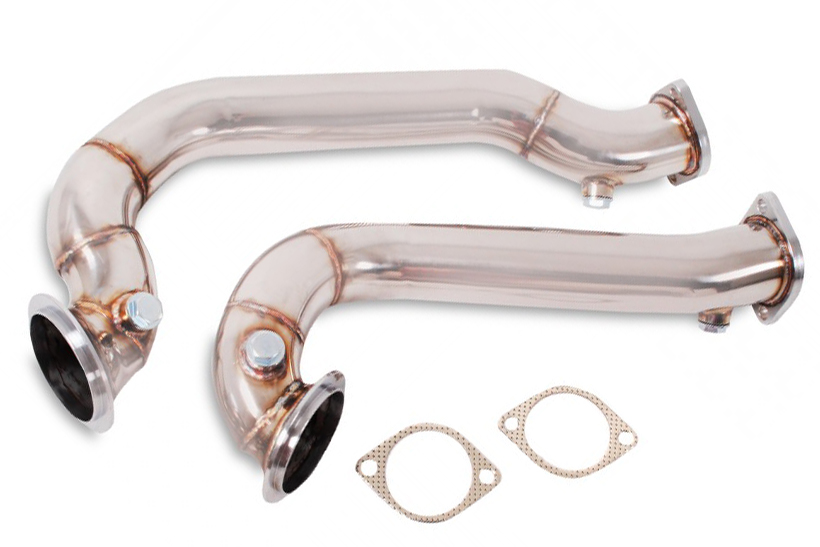
Why are de-cat pipes and DPF-deletes legal?
On the road, they’re not. But it’s perfectly legal to sell these tuning upgrades and to fit them for use elsewhere.
By nature, both cats and DPFs are the most restrictive parts in your exhaust system. So an easy way of getting more power is simply to remove them altogether. That’s all a ‘delete’ does; get rid of the restriction using a free-flowing pipe.
The reason they’re legal for racing is simply a numbers game. There are roughly 1.4 billion cars on the road globally, so you and 20-of your closest pals buzzing around Silverstone for a few hours on the odd track day isn’t going to make too much of a difference in comparison.
That said, although circuits are classed as proving grounds where the laws of the land don’t apply, many pro race cars run catalytic converters nowadays, as per their series regulations. This includes those in the BTCC and WTCC. Rally cars, especially those that run on road stages, are also required to run cats. In many cases you’ll see these welded right the end of the exhaust just before the tailpipe, just to stop them melting when the car is at full chat!
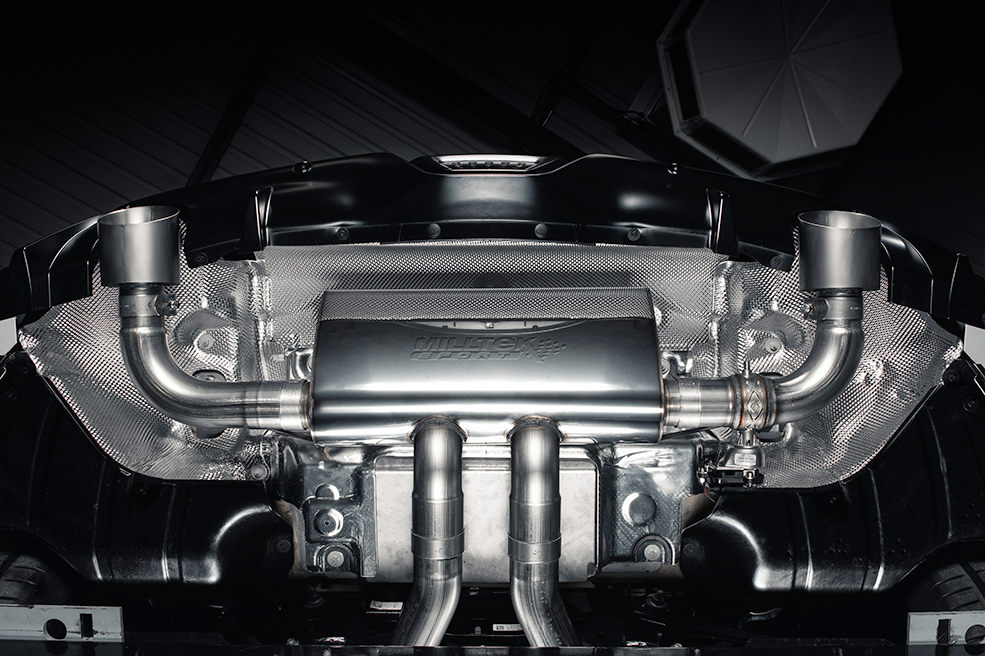
Why would I upgrade my standard cat-back exhaust?
There’s no doubt that a performance cat-back or DPF-back is one of the all-time great basic bolt-ons. For many it’s the very first tweak they’ll look for when modifying any car. We’ve been there ourselves many, many times.
In the real world there’s three main reasons you should consider an aftermarket upgrade. These are performance, longevity and aesthetics…
How can a cat-back exhaust upgrade improve performance?
Even though it’s not the priority for many, increasing performance is perhaps the main purpose of any aftermarket exhaust system. They’re not called performance exhausts for nothing, right? In fact, all the most reputable manufacturers go to great lengths to design their cat-back and DPF-back systems for maximum gas flow. But, most importantly, they do this without making them too loud for road use.
When performance tuning your engine the idea of any exhaust upgrade is to allow your lump to breathe more effectively. The idea is to get those waste gasses out as quickly and efficiently as possible. The faster they’re out, the quicker the engine can shovel in more air and fuel to be burned, netting you more power.
It’s all about freeing up the restriction caused by the standard exhaust to get those gasses out faster. And exhaust manufacturers will employ various tricks in terms of design and construction to ensure the best efficiency. Everything from smoothing out the bends as much as possible, to using less-restrictive silencers, resonators and backboxes.
They’ll also tend to use a larger diameter of pipe than standard to increase volumetric flow. Imagine breathing out through a straw all day long and then switching to a toilet roll tube. It’s exactly the same principle.
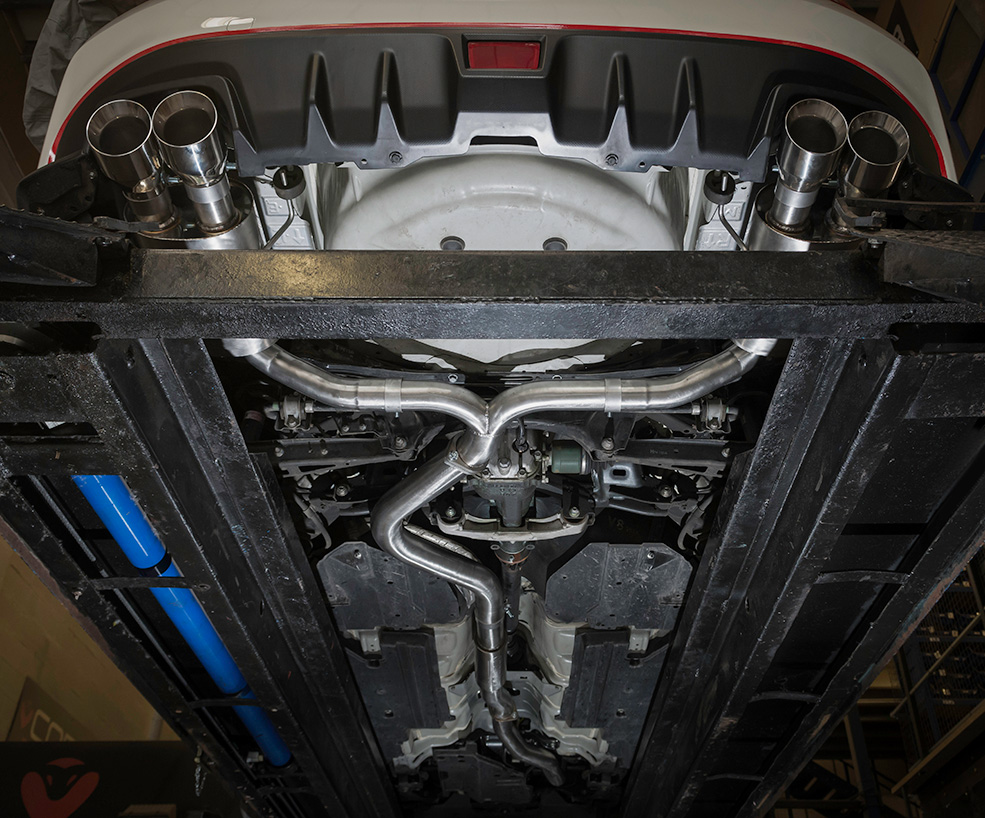
How much power will I get from an aftermarket cat-back exhaust?
As for how much power you’ll get along the way, this will depend on both the design of the new system (how much of a restriction it can free up over the standard item) and the actual engine it’s attached to. Turbocharged vehicles tend to see bigger increases than N/A cars, even the ones with massive powerplants, but generally speaking you’ll be looking at a 2-4% increase in power and torque. Even more if you throw a supporting re-map into the mix.
Why do performance exhausts last longer?
It’s all down to the materials used; most commonly stainless steel or, in some high-end systems, titanium.
For the most part standard systems are constructed from malleable mild steel, this makes them cheap to produce and particularly resilient to scrapes and knocks. This is great news if you happen to be a car maker with thousands of vehicles coming off the production line. Particularly vehicles that get smashed around by people who don’t really care. Basically, you’re quids in. And forking out the extra cash for posh materials, which are also much harder to work with, isn’t going to be your top priority.
There is a design argument for sure. But, even when it comes to making a standard car look nicer,
it’s much cheaper to disguise the standard system with shiny bolt-on tailpipes or a stainless surrounds built into rear bumper – Mercedes, Honda, Vauxhall they’re all at it nowadays. Look a little closer though, and you’ll see that the pipes, silencers and backbox will nearly always be mild steel.
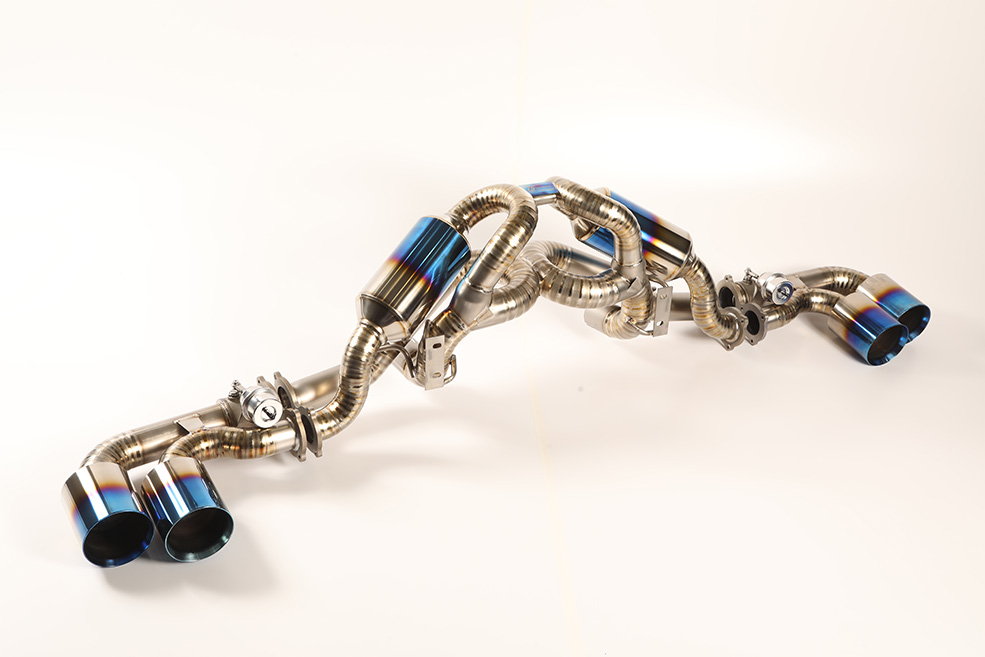
Advantages of stainless steel and titanium cat-back exhausts
The problem with mild steel is that it rusts. And, when you put it underneath a car with all the road salt and corrosive grime flying about to accelerate the oxidation process, it becomes almost inevitable that your standard exhaust will fail at some point. Now granted, that’s not going to be in the first few years, but it will happen. But then again, if you’re the car dealer and the warranty is long gone, that’s not really your problem, is it? You may even get to flog them a replacement down the line.
However, stainless steel and titanium won’t rust and, assuming you opt for a reputable exhaust manufacturer, the high-quality tig welding in between won’t use mild steel, so that won’t rust, either. This means that any good performance exhaust should last the lifetime of your car at the very least. Just think about it, how many times have you seen a second-hand upgrade for sale online? That should tell you everything you need to know.
What about aesthetics though?
It’s no secret that performance exhausts tend to look better. And we’re not just talking about to those in the know. Even if you’re not the world’s biggest car fan, a nice shiny exhaust is far more appealing than a rusty old pipe sticking out of the back. Nowadays of course, many of the best performance systems are also available with a choice of tailpipes made from everything from titanium to carbon fibre. Yes, it’s a wonderful time to be alive!
But all that said, exhaust aesthetics isn’t just about the eyes, but your ears, too. The vast majority of modern performance systems are tuned specifically to give the a nice grumble. Some manufacturers even trade off of the fact that nothing sounds quite like their systems. And they’d be correct, because every one designs their exhausts differently. This is why sonic engineering is a huge part of the art, but something that goes unnoticed to many.
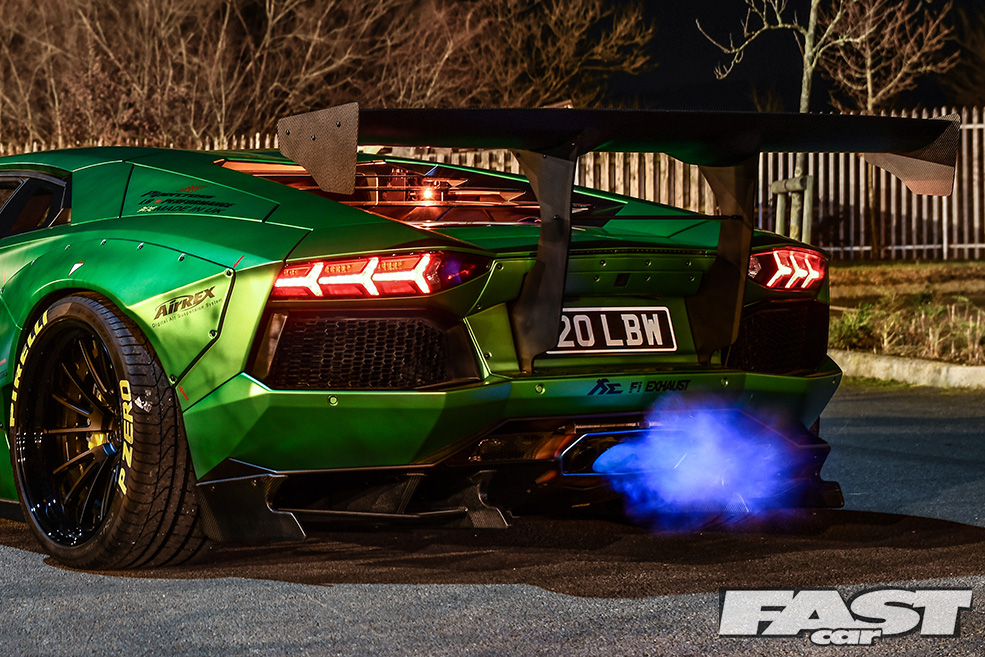
Maximum efficiency
From a performance standpoint of course – if we’re getting all hung up on maximum efficiency – the freest-flowing exhaust would be a big, straight pipe with no restrictions, no silencers and no backbox. Unfortunately, this isn’t possible for two reasons.
First, your performance system usually has to follow the same route under the car as the standard part. Most vehicles will have a gully that’s heat shielded, and this is rarely in a straight-line from front to back. And second, at best an exhaust with no silencers would make the car uncomfortable to drive, and at worst it would be so loud that you’ll be told to take it off by the police… and probably receive a fine for your troubles.
For exhaust manufacturers it’s a trade-off between performance and practicality, all the while tuning the sound to remain within a reasonable limit. Offering a mild performance roar, rather than some sort of sonic assault on everyone else. A well-designed system will employ high-flow silencers and resonators designed to help keep the noise down but give way better performance over standard.
Can I replace the whole exhaust system?
So, a cat-back or DPF-back exhaust system is a worthwhile investment then, but what about cutting down on the biggest restriction of them all, without resorting to mods that are going to be illegal on the road? Well, that’s where performance cats and high-flow DPFs come in. These are going to cost you a fair bit more, that’s for sure, but there are plenty available from the big brands. The idea is simple, these help to flow more gasses, while still offering enough control over emissions to keep your car within the legal limits. For more on these, and other performance parts such as downpipes and manifolds check out our full Guide To Exhausts.
Words: Midge Burr.

